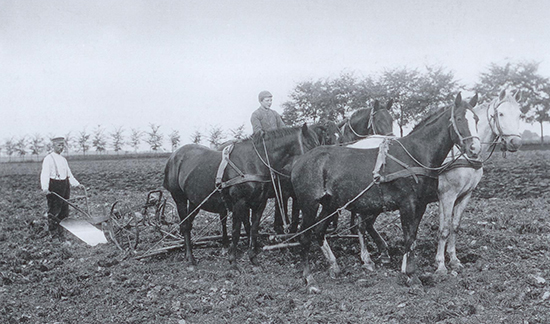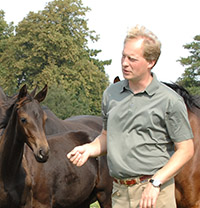 Wherever you go in the world of European Warmblood breeding you here the same lament – Alas and alack, the good old farmer breeders who made the breed great are being replaced by the new modern breeders who have no feel for breeding.
Wherever you go in the world of European Warmblood breeding you here the same lament – Alas and alack, the good old farmer breeders who made the breed great are being replaced by the new modern breeders who have no feel for breeding.
In fact, in the adjacent breeding areas of Hanover and Holstein, the new hobby breeders are blamed for totally opposite reactions. In Hanover, the new breeders are blamed for breeding only to the new, young fashionable stallions and ignoring the older, established and proven sires. Next door in Holstein, the same group – the new breeders – are blamed for patronising only the old established stallions and not giving the new young stallions a chance to prove themselves. And in each case the lament is accompanied by nostalgia for the wise old breeders of the past.
Holstein limits the breedings to their big three: Contender, Corrado and Cassini, to 350 mares each. If you wish to breed to Contender, for example, you need to have bred to a younger stallion the year before, and only mares with a high percentage of Thoroughbred blood are accepted. In 2006, there were 700 applications to use Contender – twice the number accepted.
In Hanover, while it is hard to get the breeders to use the older stallions, in Holstein it is hard to get them to use the younger stallions…
According to Holstein director, Norbert Boley:
“It’s a big difference in our breeding area. The market in other breeding areas is much more in the direction of dressage and they can easily sell the foals – they are very pretty and with big movement. In our area, the people prefer to breed jumpers, and if the product has a really good pedigree, it’s a good selling point. The movement is not so important, they believe much more in the breeding lines. If there is a foal from Contender or Capitol, or ten years ago, by Landgraf, then there is a pretty good guarantee that the foal will be a jumper, and that creates the market. It is not possible to do it with a foal by a younger stallion, no one knows about his progeny. That’s the difference between our breeding area and others.”
You encourage the breeders to use the younger stallions – if they want to breed to Contender, they have to also breed to a younger stallion…
“There is a great deal of interest in using the older stallions, it’s nearly a guarantee to make money if you breed a foal by one of them, so all the breeders want to use these stallions, it is very simple if you breed to them. So we made a combination that also gives us a chance to bring the young stallions into the breeding system, at the moment it works well, it is now accepted because if we have no way to bring up the young stallions, we have no chance of producing top stallions for four or five years time.”
“It was the same discussion ten years ago when we had Cor de la Bryère, Lord and Landgraf, as the three heroes, and everyone was asking what happens after these three stallions? We had to work to bring up some young stallions, but it was successful. Today, the breeding situation is more extreme than it was ten years ago – with artificial insemination it is possible for a stallion to cover more mares now, we have to be careful that we don’t have just three or four stallions in our breeding area, so that in the future we have good young ones.”
The number of mares a stallion can have is limited?
“At the moment it is 350 for the old famous ones. The stallions have to show us that they have good offspring, not just one outstanding foal, before we let them cover many mares. We are always working in relation to our not very big mare band – in Hanover it is nearly 20,000 mares, here it is 7,500, so it is a different world for us, we have to be a little bit careful. Also from the point of view of marketing, it is more interesting if every year there are just 250 foals from Contender or Cassini, so that there is a good market for them. If there are 500 or 700, there is not so much interest. How many mares the young stallion breeds depends on their performances. After their performance test, they start with 80 and as they get older they can cover 150, then the big step is to 350 but that is just a few stallions.”
How different things are in Hanover, where the breeders flock to the previous year’s licensing champion, breeding – as three year olds – over 500 mares each, while proven stallions are largely ignored.
“It’s crazy,” noted stallion keeper, Ingo Pape, remarked to me recently, “all the breeders want to know is what new stallions will you have this year? With a stallion like Davignon, we know what he produces, and which mares he works well with, and yet the breeders don’t want to know about him!”
The trend is even affecting the Studbook Zangersheide, in neighbouring Belgium. In an editorial in the June 2008 edition of Z Magazine, Leon Melchior warns:
“Every year new young stallions turn out to be direct hits. The number of orders for the sperm of some of them is even running into the hundreds, so much that demand can barely be met. It is advisable for the breeders not to forget about the stallions that have proved themselves in the top sport and that were in the past responsible for the supply of top-class showjumping horses. It would be a shame if the basis on which Zangersheide was built by our breeders would start leaning too much towards promising new stallions. We can understand our breeders well, since we are co-responsible for the trend to use new blood. We used to do so in our own studfarm. But over the years we have come to reconsider, and have gone back to having a large part, at least 60% of our mares, served by older stallions still present, such as Coriano Z and Candillo Z and by stallions that we regretfully had to do without for some time, such as Caretano Z and Chellano Z.”
Germany is unique amongst the European horse breeding countries in that how many mares each stallion covers each year, is a closely guarded secret. The Stud Books have an agreement with the FN which prevents the release of individual stallion totals, even though Klaus Miesner of the FN breeding department, agrees that breeders should have this information made available to them. The studbook officials argue that to release the figures would further increase the tendency to breed in massive numbers to the current ‘hot’ stallions.
Still it is widely believed that Paul Schockemöhle’s 2006 Hanoverian licensing champion, Hotline, bred to 800 mares in his first season – and this trend can be seen in a number of breeding areas, not just Hanover, but also in Westfalia, and more strongly, in Oldenburg.
In an effort to arrest this trend, the Hanoverian Verband decided in 2008 that there would be no champion at future stallion licensings, hoping then that the breeders will use more of the top young stallions in future and not just the winner. I guess the truth is that the breeders will still send the most mares to the most expensive stallion – which leaves the way well and truly open for rich stallion owners to manipulate the market.
The Holstein authorities dismiss this new trend of fashion breeding as madness but wish that a few of their breeders would give some of their younger stallions a chance, and usually reminisce about the passing of the ‘good old breeders’. Everywhere the story is the same – as we have seen, even in that home of tradition, Ireland, the suggestion is that we are losing the wisdom of the ages…
There are a few dissenting voices. France’s Arnaud Evain is always his own man, and he is not so sure about the effect of the change: “I am not sure how much knowledge is being lost with the change. Just because some of the traditional breeders who knew the horses very well are disappearing, it doesn’t mean the knowledge is disappearing. Sure we have the same change in France, but the knowledge is still there, the new breeders need to get the knowledge, but the knowledge does not disappear. A lot of the newcomers in the breeding come with a lot of passion, more passion than the farmers used to have, so there is no danger there.”
Another who questions this revealed ‘wisdom’ is Hanover’s Ludwig Christmann: “I don’t like the controversy between the good old breeder and the naïve hobby breeder. I think this is romantisizing the old breeders and it is unfair to the new breeders. I agree with Arnaud Evain that there are bad old breeders and good new breeders. We need new people who start breeding and I think we have a good mixture. In our breeding area I see a tendency that the new generation of the old breeding farms, become more and more professional. They offer their services with regards to breeding and board mares all year round. Mares foal on their farms, they are re-bred, and the foals are raised there – especially with the globalisation of horse breeding this seems to be good business. Examples are breeders like Jens Meyer or Hans Heinrich Brüning – farms like theirs are very important sources of knowledge for the new breeder.”
I tend to agree with Arnaud and Ludwig. I have interviewed a number of these ‘wise old breeders’, amongst them some of the most celebrated, and have found with distressing frequency, that many of them seem to have just been plain lucky. If you set out to breed jumping horses, and along the way create a mare pool that produces brilliant dressage horses, is this testimony to your wisdom? If you have a fight with one local stallion keeper, and take your mare the next season to his rival, and then produce a champion – or breed to a particular stallion because he is cheaper than the alternatives with great results – luck or wisdom?
The truth is that for most of these traditional breeders they had very little choice. Even into the 1980’s, they only just managed to get their mare to the local show hitched to the farm tractor, they certainly were in no position to drag her to the other end of the country to seek the sire of their choice. They bred to whatever stallion the head of the stud sent to their district… and given the continued failure of all of the major Warmblood licensing commissions to even recognize their future top stallions when they came before them at the Stallion Licensings, you have to wonder at the wisdom of the good old breed society administrators.
Every now and then I ask a breed society publicist to take me to meet one of these fabled traditional breeders, and most often I end up at a farm where it is true that horse breeding has been conducted for many generations, but most of the time, the current head of the breeding operation, while descending from traditional stock, comes with a university degree, runs a multi-lingual website and is working on developing a world-wide marketing strategy.
Many of the old farmers with their one or two mares are currently experiencing enormous difficult in selling their young stock, but this is often due to their greed. They have one nice old mare, who when bred to a classy modern stallion produces a couple of very nice foals. Instead of keeping one of these really good fillies to improve their line – they sell the filly, and keep breeding to the good old mare. It is results in the ‘every other year’ syndrome. You will find out in the paddock a lovely yearling while the foal currently on the mare looks as if it has come out of a Warmblood museum exhibit. Why? Because the old mare can throw to the stallion and produce something modern, or she can breed a dinosaur like herself. And of course the problem for the purchaser of that nice filly is that it can, unfortunately, throw back to its old fashioned granny.
I suspect those vilified new breeders who are prepared to pay good money and buy the nicer young stock perhaps have a greater chance of success. I suspect for every wise old traditional breeder there were a score of ignorant ones, and that amongst the ranks of the new breeders, there are at least as many who do think carefully and creatively about their breeding program… having said this I remember a conversation with one of Germany’s largest and most successful dealers, when I remarked that it was extraordinary that many super smart businessmen when they went to buy a horse, left all their business smarts back in their office. “Yes,” he said, with a smile.



